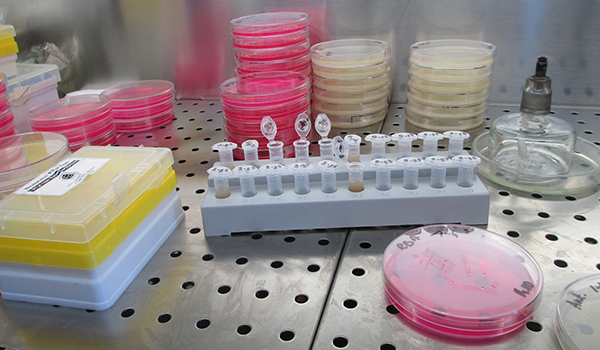2016-12-09
While problems with antibiotic discovery and development are often discussed in the context of funding and return on investment, these factors are not the only ones. Even if the financial bottlenecks would be resolved, significant scientific and structural problems are still present and need to be addressed. Below, we highlight a few of the scientific bottlenecks in antibiotic discovery, with links to further reading.

Two challenges in discovering new antibiotics
The most common path to identifying potential new drugs is through screening a library of chemical compounds against a proposed target molecule, such as a cellular receptor or an enzyme. The hits, or compounds that bind to the target molecule, are then further investigated and modified to produce lead compounds, which enter the preclinical drug development phase. Here, antibiotic drug discovery faces two challenges:
- The number of hits is low in relation to other therapeutic areas.
- The proportion of hits actually generating lead compounds is much lower.
Compound libraries need to be redesigned
Comparisons of the compound libraries used and the antibiotics on the market have shown that there is very little, if any, overlapping between the chemical properties of the two groups. This is probably the cause for the low number of hits and implies that the current compound libraries need to be redesigned in order to be able to find new drug candidates. A critical examination of how antibiotics differ from the current compound libraries could provide one basis for expansion of the libraries or even creation of new libraries specific for antibiotics. Other sources for library expansion may be found in naturally occurring compounds with antibiotic or antiseptic properties, which may be found in e.g. soil, slow-growing micro-organisms, marine bacteria or plants.
Toxicity a problem
Whereas approximately 80% of the hits in other therapeutic areas generate a lead compound for preclinical development, the corresponding proportion for antibiotics is less than 10%. This difference may be attributable to issues with toxicity: antibiotics target living cells trying to either kill them or limit their growth, so unless the lead compound is highly selective for a target molecule only found in bacteria, the high concentrations required for sufficient penetration into the bacterial cells are likely to cause toxicity in the patient. Better knowledge of drug uptake and efflux mechanisms in bacteria, especially Gram-negatives, may result in optimisation of the compound libraries to improve this hit-to-lead ratio.
Researcher incentives need revision
Increased funding of academic research been proposed as one solution to the crisis in innovation and drug development. This approach is, however, not unproblematic. In academic research, the basis for funding and fame is publishing, and publishing in high impact journals requires novelty. This is in stark contrast to the realities of drug development, where protection of intellectual property limits the possibility to publish the most recent findings. And when the arduous work with testing the many facets of the lead compound in pre-clinical development commences, the results lack the requirements of scientific height and novelty to be published in high impact journals. Thus, many academic researchers are not interested in pushing a lead compound past the initial discovery and through the pre-clinical phase. In order to overcome these obstacles, researcher incentives need revision: delinkage of funding from publishing and also rewarding other accomplishments might be one path forward.
A great need for antibiotic stewardship
These are just three examples of how antibiotic drug discovery and drug development face challenges that are contributing to the lack of new antibiotics. Thus, even if all financial issues were resolved with e.g. delinkage approaches, there is still a great need for antibiotic stewardship in order to avoid resistance development and lengthen the life span of these crucial drugs.
Further reading
Zorzet, Anna. “Overcoming Scientific and Structural Bottlenecks in Antibacterial Discovery and Development.” Upsala Journal of Medical Sciences 119, no. 2 (2014): 170–75. doi:10.3109/03009734.2014.897277.
Lewis, Kim. “Platforms for Antibiotic Discovery.” Nat Rev Drug Discov 12, no. 5 (May 2013): 371–87. (Paid content)
